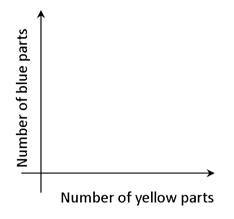Art Class, Variation 1
The students in Ms. Baca’s art class were mixing yellow and blue paint. She told them that two mixtures will be the same shade of green if the blue and yellow paint are in the same ratio.
The table below shows the different mixtures of paint that the students made.
| A | B | C | D | E | |
| Yellow | 1 part | 2 parts | 3 parts | 4 parts | 6 parts |
| Blue | 2 part | 3 parts | 6 parts | 6 parts | 9 parts |
- How many different shades of paint did the students make?
- Some of the shades of paint were bluer than others. Which mixture(s) were the bluest? Show work or explain how you know.
- Carefully plot a point for each mixture on a coordinate plane like the one that is shown in the figure. (Graph paper might help.)
- Draw a line connecting each point to (0,0). What do the mixtures that are the same shade of green have in common?


